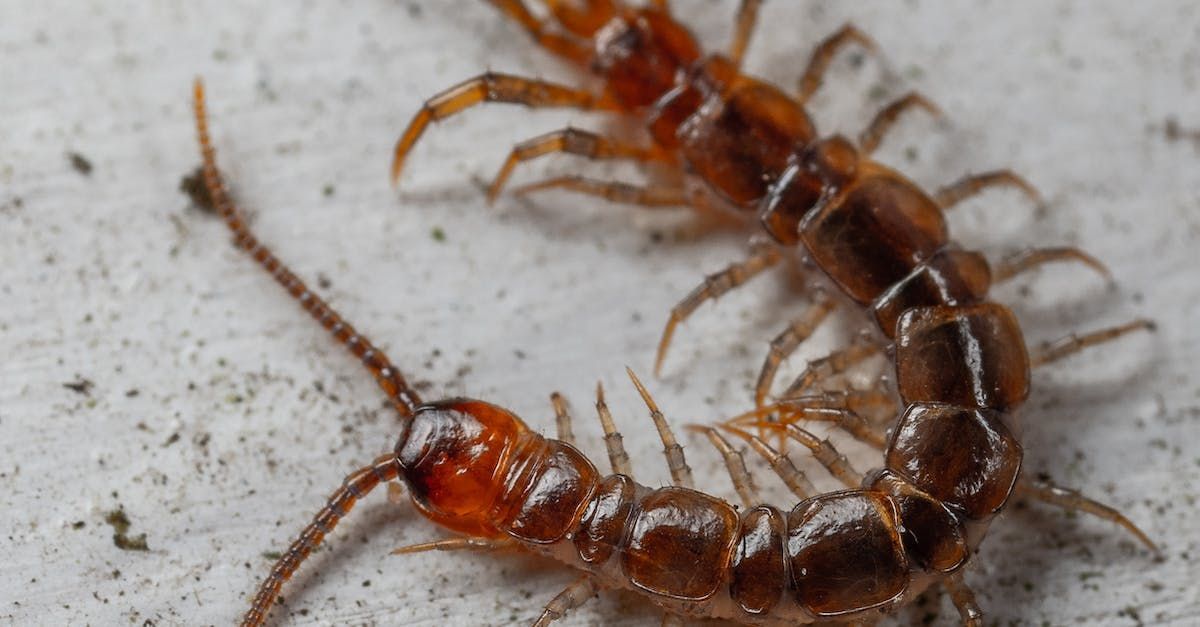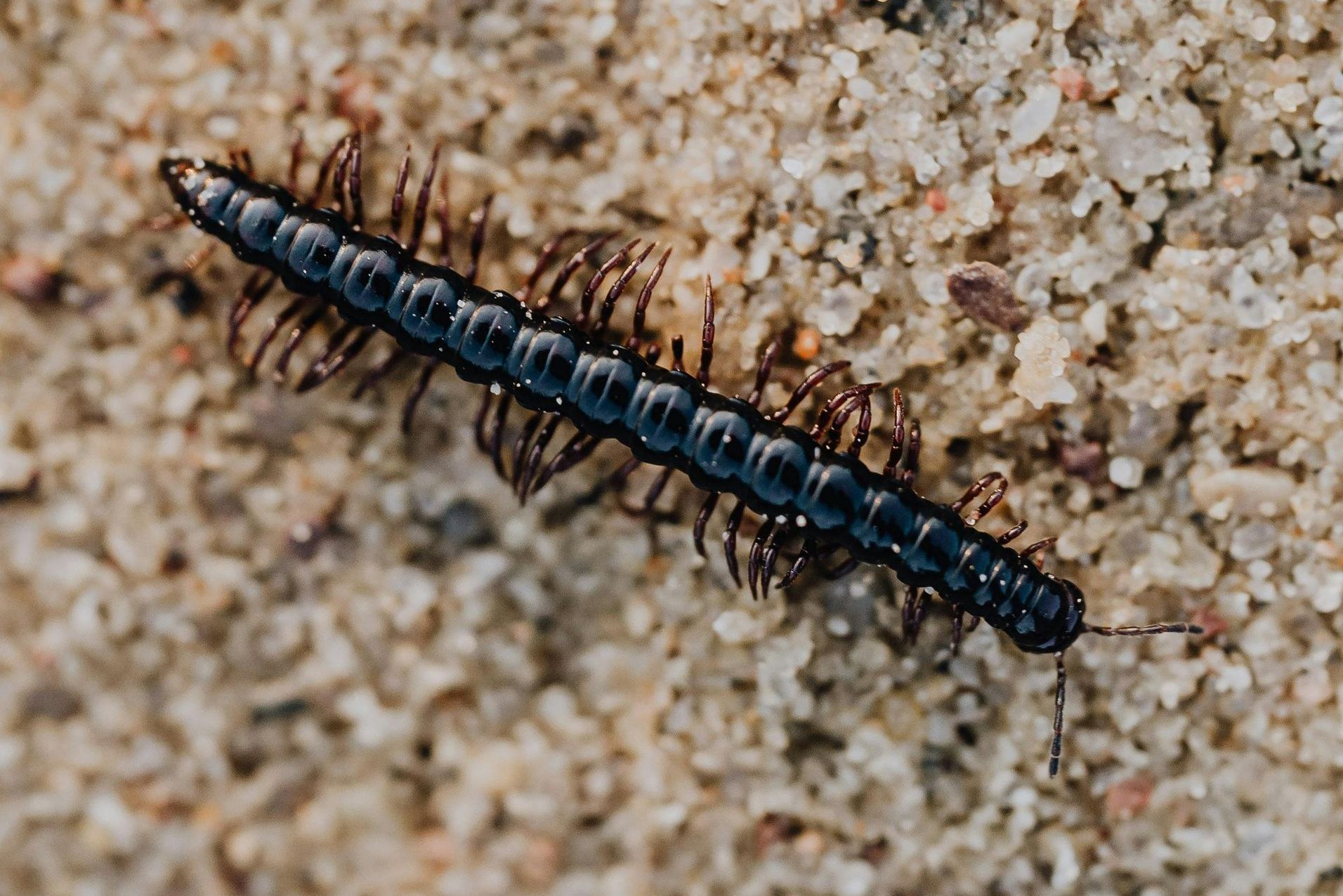Millipedes and Centipedes
Millipedes and centipedes may seem like harmless creatures, but they can become a real concern for homeowners, especially when they start making their way indoors. These pests are often attracted to dark, damp environments, and homes with high moisture levels, such as basements, bathrooms, and crawl spaces, provide the perfect habitat for them.
While millipedes are mostly a nuisance when they invade in large numbers, centipedes can pose a greater worry due to their ability to bite and release venom. Their presence not only indicates potential issues with moisture and other pests, but they can also cause discomfort and anxiety for homeowners who encounter them. Effective control and prevention are essential to keeping these pests at bay and maintaining a comfortable living environment.

If you have any questions, here are a few of the frequently asked questions.
If you're dealing with centipedes or millipedes in your home, you're not alone. These common pests often spark questions from homeowners about how to prevent or eliminate them. That’s why we’ve compiled a list of frequently asked questions (FAQs) to address the most common concerns regarding centipede and millipede control, prevention, and removal.
Did you know that centipede can actually be beneficial in small numbers? They are natural predators and help control other insects like spiders, ants, and cockroaches. However, when their presence grows, they can become a nuisance. On the other hand, millipedes, despite being harmless to humans, can release a defensive chemical when threatened that can irritate skin and eyes.
Understanding their behavior and biology is the first step in keeping your home pest-free.
1. What attracts centipedes and millipedes to my home?
Centipedes and millipedes are often attracted to damp, dark environments. They can enter homes seeking moisture, food, and shelter, especially if there are leaks, high humidity, or organic matter like leaves and mulch near the foundation.
2. Are centipedes and millipedes dangerous?
Centipedes can bite and release venom, which may cause mild pain and swelling, but they are generally not dangerous to humans. Millipedes do not bite, but they can secrete a defensive fluid that may cause skin irritation.
3. How can I prevent centipedes and millipedes from entering my home?
Reduce moisture levels inside and outside your home by fixing leaks and using dehumidifiers. Seal cracks and gaps around windows, doors, and the foundation. Remove piles of leaves, mulch, and other organic debris from around your home.
4. What is the best way to get rid of centipedes and millipedes?
Regular vacuuming, removing moisture sources, and sealing entry points can help control them. For severe infestations, professional pest control treatments may be necessary, using targeted insecticides or bait.
5. Why are centipedes and millipedes more active at night?
Centipedes and millipedes are nocturnal creatures, meaning they are most active during the night. They prefer the cover of darkness to hunt for food and seek out moist areas.
6. Will centipedes and millipedes cause damage to my home?
Centipedes and millipedes generally do not cause structural damage to homes. However, they can become a nuisance if they enter in large numbers, and millipedes may sometimes damage seedlings or plant roots in gardens.
7. What should I do if I find centipedes or millipedes inside my home?
Remove them with a vacuum or paper towel and release them outside. Check for entry points and seal any gaps or cracks. Reducing humidity and moisture inside the home can also help prevent future occurrences.
8. Can centipedes and millipedes infest my home?
While it's unlikely for centipedes or millipedes to "infest" a home in the same way as ants or termites, they can enter in large numbers under the right conditions, such as high moisture or an abundance of food sources.
9. Are there natural ways to control centipedes and millipedes?
Yes, reducing moisture, using diatomaceous earth around entry points, and removing their food sources like small insects and organic matter can help control them naturally.
10. When should I call a professional for centipede or millipede control?
If you notice a large number of centipedes or millipedes inside your home, or if DIY methods have not been effective, it’s best to call a professional pest control service. They can assess the situation and provide targeted treatments to address the issue.
Understanding the types of millipedes & centipedes in your household

Not sure which type of millipede or centipede you’re seeing in your home? We’ve compiled a detailed list of the most common species to help you identify them. Whether you’ve spotted the fast-moving, many-legged house centipede or the slower, curled-up millipede, understanding the specific type can help you address the problem more effectively.
Each species has its own unique habits and behaviors, and knowing what you're dealing with can make a big difference in controlling the situation. While some centipedes may be beneficial by preying on other insects, others may become a nuisance or even pose a minor risk with their bites.
Millipedes, though harmless to humans, can enter your home in large numbers and create an unpleasant mess. If identifying or managing these pests seems overwhelming, it’s often best to contact a professional exterminator who can offer expert advice and effective removal solutions tailored to your situation.
1. Carpet Beetles (Dermestidae Family)
- Varied Carpet Beetle (Anthrenus verbasci): Small, round beetles with a mix of black, white, and yellow scales. Larvae feed on natural fibers like wool, silk, and leather.
- Black Carpet Beetle (Attagenus unicolor): Shiny black adults, while larvae are carrot-shaped and brown. They infest carpets, clothing, and stored food products.
2. Powderpost Beetles (Lyctinae Family)
- True Powderpost Beetle (Lyctus spp.): Infests hardwoods like oak, maple, and ash. They leave behind fine, powdery frass and small, round exit holes in wood.
- False Powderpost Beetle (Bostrichidae Family): Targets both hardwood and softwood, often found in old furniture and wooden structures.
3. Pantry Beetles (Stored Product Pests)
- Confused Flour Beetle (Tribolium confusum) and Red Flour Beetle (Tribolium castaneum): Small, reddish-brown beetles found in flour, cereals, and other stored food products.
- Sawtoothed Grain Beetle (Oryzaephilus surinamensis): Brown beetles with distinctive serrated thorax edges, often found in dry goods like pasta, cereals, and pet food.
- Drugstore Beetle (Stegobium paniceum) and Cigarette Beetle (Lasioderma serricorne): Small, brown beetles that infest a variety of dried foods, spices, and even non-food items like books and leather.
4. Wood-Boring Beetles
- Furniture Beetle (Anobium punctatum): Infests wooden furniture, structural beams, and flooring. Leaves small, round exit holes and powdery frass.
- Old House Borer (Hylotrupes bajulus): Larger beetles that attack softwood timbers, often in older homes. They create oval exit holes and coarse frass
5. Ground Beetles (Carabidae Family)
- Common Ground Beetles: These beetles are typically black or dark brown and are more nuisance pests when they wander indoors, often searching for shelter or prey.
6. Lady Beetles (Coccinellidae Family)
- Asian Lady Beetle (Harmonia axyridis): Similar to native ladybugs but can become a nuisance when they congregate in large numbers indoors during the fall.
7. Click Beetles (Elateridae Family)
- Common Click Beetle: These beetles get their name from the clicking sound they make when flipping themselves over. They are usually harmless but can enter homes seeking shelter.
8. Ground Beetles (Carabidae Family)
- Black Ground Beetles: Often found in basements or ground floors. They are typically harmless but can become a nuisance if they enter homes in large numbers.
9. Wharf Borer (Nacerdes melanura)
- These beetles are commonly found in older homes with decaying wood or damp basements. They can cause structural damage to wood.
10. Cigarette Beetles (Lasioderma serricorne)
- These small, reddish-brown beetles infest stored tobacco products, but they can also feed on a wide variety of dried foods and spices in the pantry.
Pest extermination control services for a hassle-free experience.
At GetLocal Services, our platform's transparent pest control pricing eliminates the need for price shopping. Our system provides you with the best price based on the experience and qualifications of our thoroughly vetted exterminators.
Our professional network members undergo a rigorous vetting process to ensure they meet our high standards. This guarantees that you receive top-quality service at a fair price, making your experience with us completely hassle-free.
Avoiding Annoying Sales Calls
One significant advantage of using GetLocal Services is avoiding the annoyance of multiple sales calls from vendors vying for your business.
Once you select an exterminator through our platform, you won’t be bombarded with follow-up calls from other vendors. This ensures a stress-free experience, allowing you to focus on resolving your pest problem easily.
Our professionals are available in your area if you need a millipede and centipede exterminator.
If you’re facing a infestation, our local exterminators are here to help. We specialize in treating the specific types of pests in your area, using effective methods to eliminate the problem and prevent future issues. Contact us today to schedule an inspection and keep your home pest-free.
DELAWARE
FLORIDA
GEORGIA
NEW JERSEY
PENNSYLVANIA
NORTH CAROLINA

Money-Back Guarantee!
Unhappy with the service? We'll send another provider. Still unsatisfied? Our money-back guarantee will make it right.
GetLocal Hassle-Free Home Services
ARE YOU A HOME SERVICES PROFESSIONAL?
Partner with us to connect with homeowners who seek trusted professionals, boosting your visibility and reputation in your community.

SERVICES
TOP LOCAL SERVICE AREAS
- New Jersey
- North Carolina
- Florida
- Georgia
- Pennsylvania
- Delaware
- USA
JOIN OUR MAILING LIST
Sign up for home services tips and more
Join the Newsletter
We will get back to you as soon as possible
Please try again later
Copyright, GetLocal Services, LLC. | All Rights Reserved. | Terms of Use | Privacy Policy








